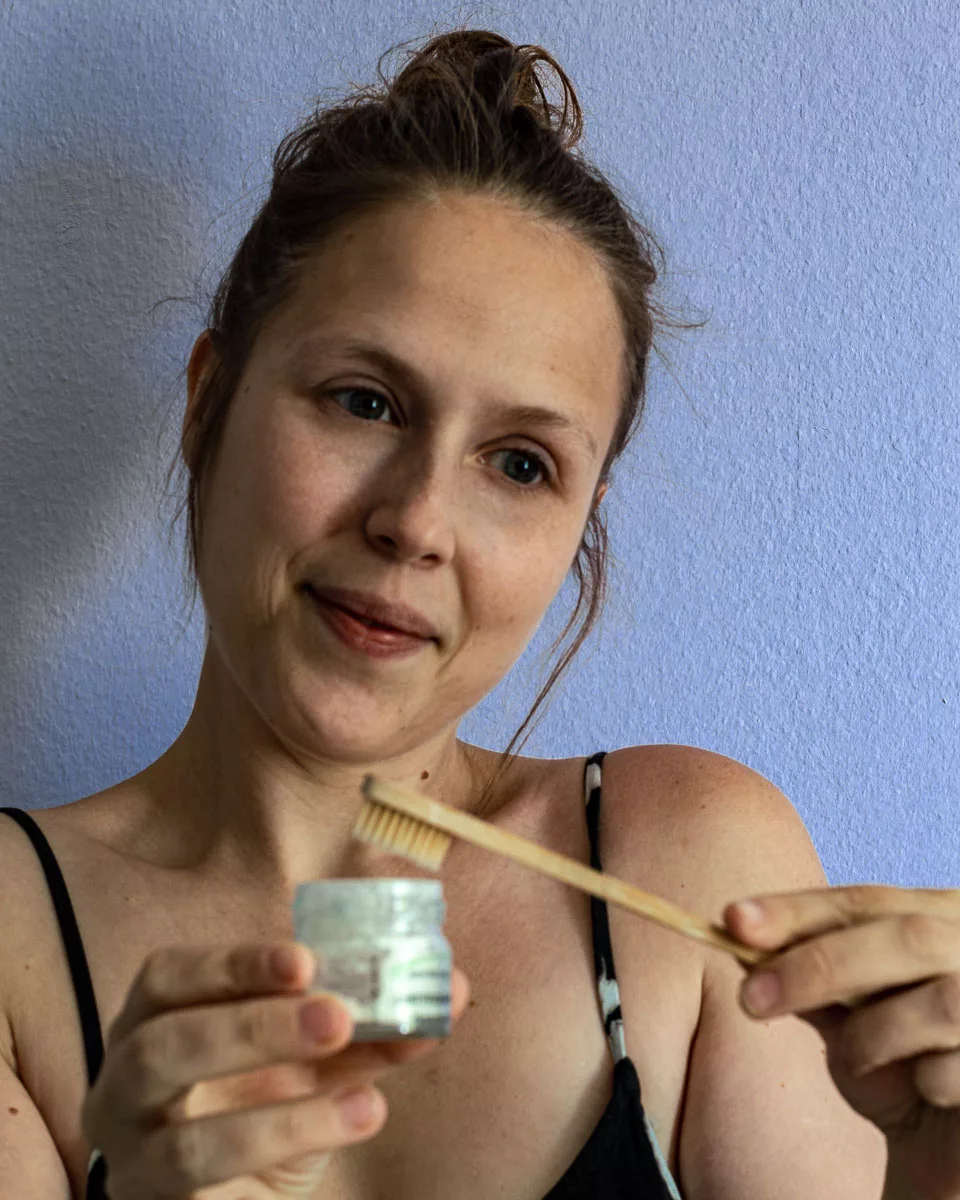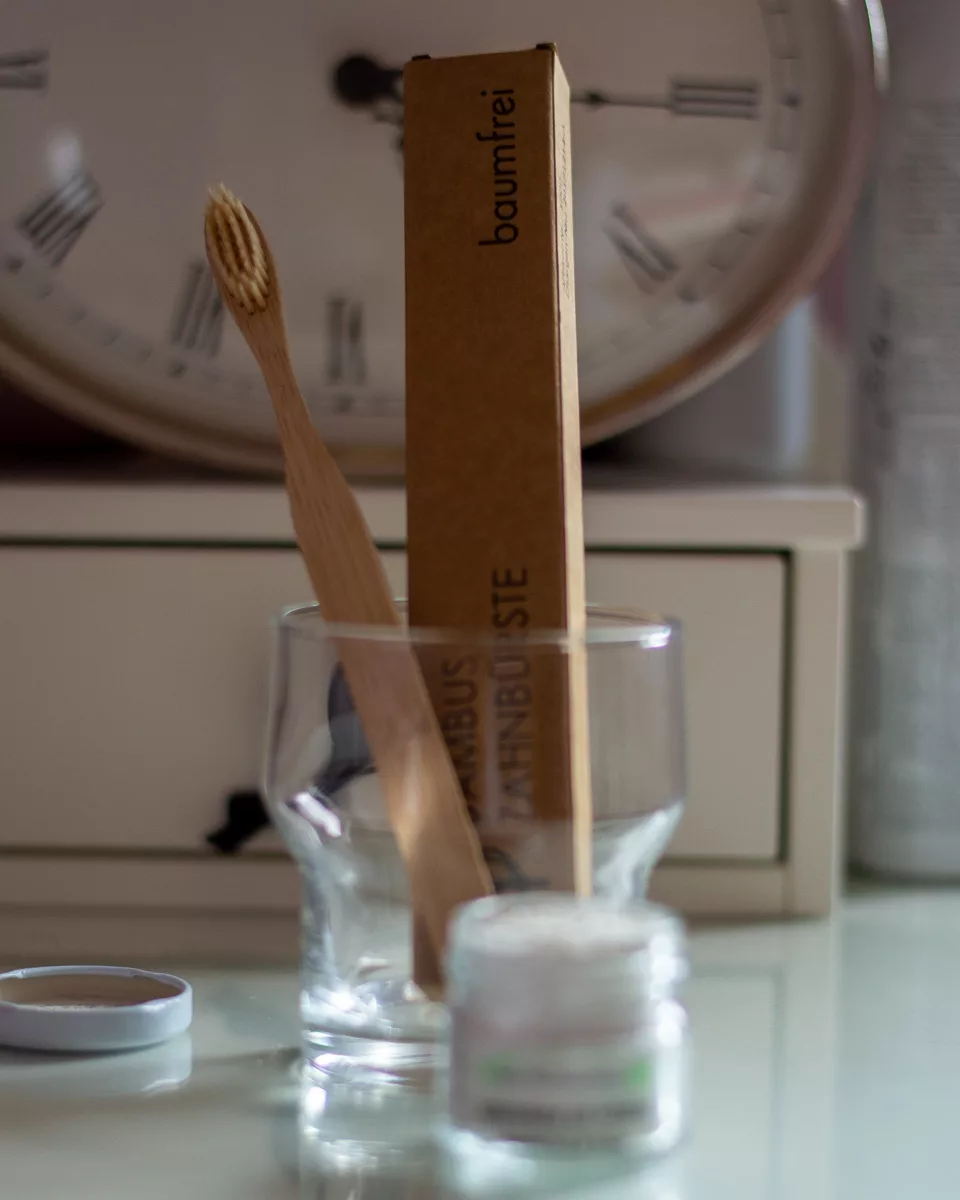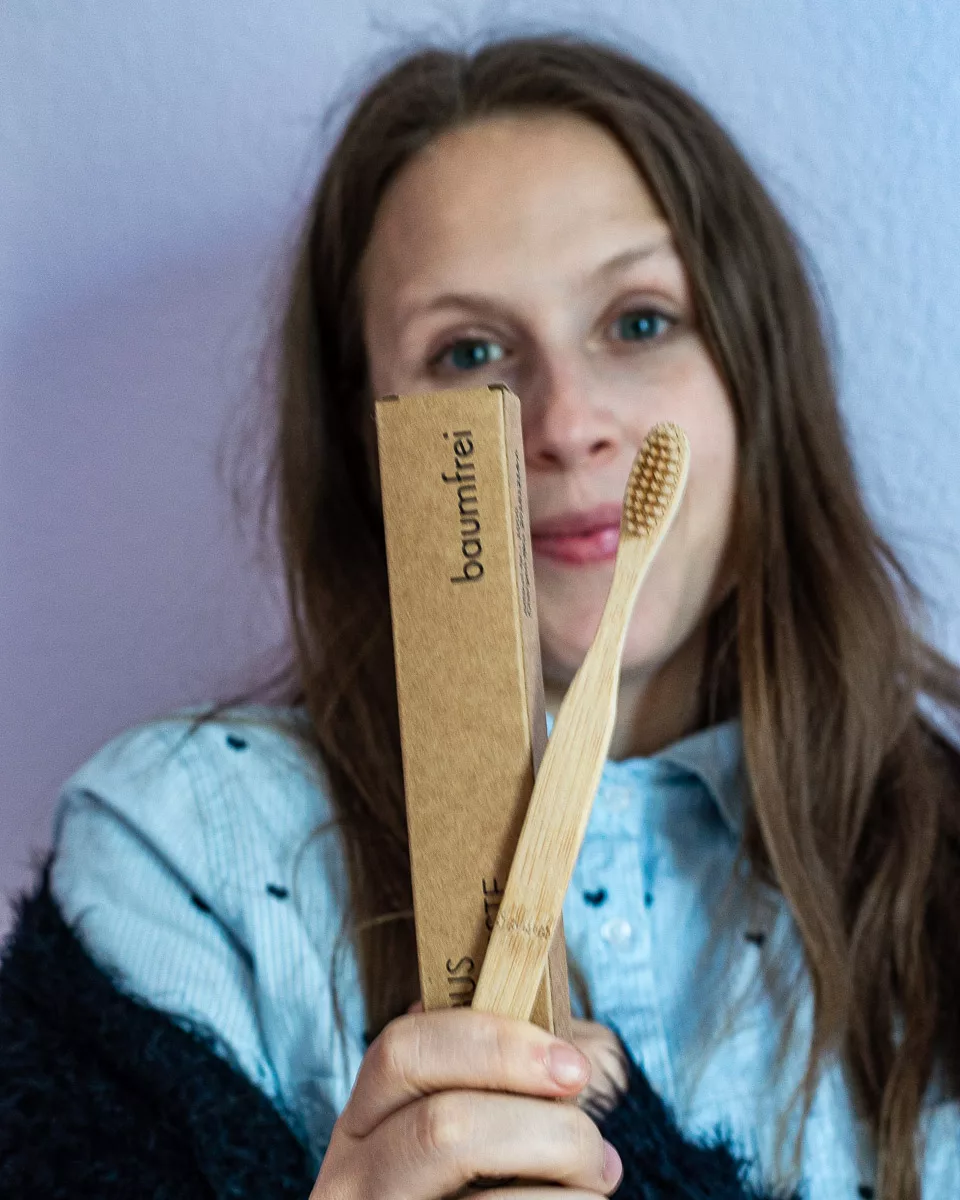This post is also available in:
Deutsch
This blog post also is available in German.
A plastic toothbrush takes up to 500 years to completely rot. And on average a toothbrush should be changed every 3 months! If you sum this up to the entire world population, then it quickly becomes clear that a sustainable and above all plastic-free alternative is needed! We don’t even want to talk about the huge amount of plastic swimming around in our oceans!
But are bamboo toothbrushes really sustainable and plastic-free? What about their ecobalance? Are there possibly more environmentally conscious alternatives? And what about the hygiene and efficiency of such brushes? Questions about questions we want to address today.
How efficiently do bamboo toothbrushes clean your teeth?
Bamboo naturally has an antibacterial effect, which has positive effects on our oral hygiene. In principle – as with all toothbrushes – you should pay attention to use soft bristles. Besides that never brush your teeth using pressure. Some plastic toothbrushes can bend under too much pressure, bamboo toothbrushes can’t. Therefore, really pay attention to pressure-free cleaning. Otherwise, bamboo toothbrushes are just as efficient as any other manual toothbrush. However, it may not be as efficient as an electric toothbrush. This is mostly due to the cleaning technique rather than the toothbrush itself. Electric toothbrushes guarantee easy and correct cleaning.
I`ve never used electric toothbrushes and don’t notice any difference in cleaning power compared to a plastic manual toothbrush. For me an electric toothbrush is absolutely not an option and I give priority to sustainability. I also have my teeth professionally cleaned by a dentist every 6 months.
But if you still don’t want to live without an electric toothbrush, you can try happybrush. At least their packaging is sustainable. But it makes no sense to exchange a fully functional electric toothbrush, which you already have at home, for a new one. After all, happybrush is plastic too! So it`s best to use the old one until that one stops working.
What about the hygiene and durability of bamboo toothbrushes?
I already mentioned the antibacterial effect of bamboo in the previous section. That’s why there are no hygiene concerns. However, there are a few things you need to keep in mind. A bamboo toothbrush takes longer to dry after use than a conventional plastic toothbrush. Therefore, dry after use and store in a toothbrush glass. Before brushing, check the toothbrush for mould. However, this shouldn`t happen if you dry your brush well.
As with all manual toothbrushes, the durability is 3 months. So replace every 3 months.
Are bamboo toothbrushes really plastic-free?
Unfortunately no! Bamboo toothbrushes are not 100% plastic-free.
The bristles of most bamboo toothbrushes mostly contain nylon-4, nylon-6, recyclable PBT or bamboo viscose. Most of the brands are BPA free though. At least all I`ve sencountered so far. But back to the bristles… Want to know the materials? I’ll get to that right away.
Nylon-4 & Nylon-6
Nylon-4 and -6 are plastic fibres per se! And the most important raw material for plastic is petroleum. Nylon-4 is a so-called organic-plastic, which is biodegradable. However, that term isn`t under protection and there`s no 100% guarantee producers really used nylon-4 instead of -6. You can read more about this topic in this article.
Nylon-6 is the evil brother of nylon-4! Nothing else but regular nylon and therefore not biodegradable in the foreseeable future.
PBT
PBT (polybutylene terephthalate) is also a synthetic fibre. The bristles of the Baumfrei toothbrushes – which you can see in this post and which I received as a pr sample – are made of this material. Once again it`s a synthetic, non-biodegradable fibre extracted from petroleum.
Bamboo viscose
Bamboo viscose is produced on the basis of cellulose and is semi-synthetic. During the production of bamboo viscose from bamboo cellulose, chemical processes are involved which convert the originally natural raw material into a synthetic fibre. Nothing environmentally friendly there and mostly a misleading designation. Here you can find a well written article about bamboo viscose (It`s in German though). In addition, several tests have shown that when you burn bamboo viscose bristles, the typical plastic smell occurs and the bristles melt like plastic. Natural is definitely different.
The bristles of the hydrophil brushes are said to be 100% castor oil and therefore according to the manufacturer completely biodegradable and free of petroleum. As soon as I can test these brushes, there will be an update. Unfortunately they are not available in my bulk store.
Conclusion: if you want a vegan bamboo toothbrush, you probably won`t get it completely plastic-free. The perfect toothbrush, which is vegan, compostable, 100% plastic-free and fully sustainable, doesn’t exist (maybe with the exception of hydrophil brushes). Unfortunately you will have to live with that.
Are bamboo toothbrushes completely compostable?
Completely compostable is not vegan. Ouch, that sounds harsh doesn’t it? But unfortunately it`s true. There actually still exist wooden toothbrushes with pig bristles. These are completely biodegradable. But unfortunately not vegan and not very hygienic. Because of the hollow bristles germs like to accumulate in them.
All vegan bamboo toothbrushes are only conditionally compostable. The bristles belong in the residual waste and only the handle in the compost bin. To do this, simply break off the head of the brush and dispose of it regularly. The hydrophil brush with castor oil bristles are very promising though. I will test them as soon as possible and give you feedback.
What is the ecological footprint of a bamboo toothbrush?
What about the ecobalance of bamboo toothbrushes? A perfectly justified question. After all, this isn`t a raw material that grows in your neighbor’s garden. Bamboo toothbrushes are mainly produced in China or India. Can the toothbrush make up for that thanks to its biodegradability? Wouldn’t wooden toothbrushes made of local wood be a better choice?
You need to consider the following facts to understand the ecobalance of bamboo. Bamboo is a fast growing wood. Within months it grows several meters and due to its rapid growth the danger of deforestation is clearly smaller. Local tree species need decades until they are fully grown and ready to be cut. Bamboo also is a very undemanding plant, it needs practically no pesticides and fertilizers. However, this only applies to places where the plant grows naturally. In our latitudes the plant would probably need fertilizer.
Like all trees and plants, bamboo also produces CO2. Not one single plastic toothbrush forms CO2. Bamboo toothbrushes get shipped ready to use. This saves a lot of space, as if bamboo were imported as a raw material.
By the way, have you ever thought about where the plastic toothbrush comes from? China accounts for 50% of plastic production, so it`s very likely that your plastic toothbrush will originate from China as well. Fräulein Öko explains the long way a plastic toothbrush makes from it`s raw material up until the very finished toothbrush ver nicely (again German though).
Overall a bamboo toothbrush imported from China is clearly the lesser evil than a plastic toothbrush that consumes oil, travels halfway around the globe forproduction, is also wrapped in plastic, and takes 500 years to rot.
Due to its rapid growth, bamboo is also a much more sustainable option than local trees. These would simply take too long to regrow.
An interesting interview on the eco-balance of bamboo toothbrushes can be found here.
Are we stealing panda`s food?
No! As far as I know, pandas feed on small species of bamboo. Bamboo toothbrushes, on the other hand, are produced from larger species. So one has nothing to do with the other.
Are bamboo toothbrushes really sustainable?
Bamboo toothbrushes are certainly not THE SOLUTION for the plastic problem. However, they are definitely a big step in the right direction and always a better choice than plastic toothbrushes, as shown above. It’s not about making everything perfect, but the best possible. And bamboo toothbrushes are a pretty good option to do so.
Are there other sustainable alternatives?
They actually exist and you will find them listed below. I didn’t find any information during my research whether miswak wood or bamboo is the more sustainable option. I also don’t know how long it takes for miswak to regrow compared to bamboo. The SWAK, for example, causes less waste though.
Miswak wood
A piece of wood from the toothbrush tree found in East Africa, Arabia and the Near East. People in these areas use sticks of this very wood since ancient time to brush their teeth. The wood of the tree is rich in tooth protecting and cleaning ingredients, such as fluoride (hardens the tooth enamel), calcium (remineralizes), saponins (cleans the teeth), flavoniode (antibacterial), tannins (adstringent), vitamin C (preservative) and silicate (cleans) (here the source I got these infromation from). A great, completely biodegradable alternative. However, sellers need to import miswak wood as well. A local alternative to miswak wood would be the hazelnut bush.
SWAK
A mixture of Miswak and plastic handle. The bristles consist of the root wood of the toothbrush tree and a plastic holder. By the way if you use miswak to brush your teeth you won`t need anymore toothpaste. The one important difference between a SWAK plastic holder and a regular plastic toothbrush? You`ll use your SWAK forever, as you only replace the miswak bristles. Meanwhile there are also models, which are made of wood, like this one. This way the SWAK per se causes less garbage than a bamboo toothbrush and you just throw the bristles in the compost bin. In terms of price, SWAK are somewhat more expensive than bamboo toothbrushes.
As long as the special cleaning technique works for you, SWAK is an equal, if not almost more sustainable alternative to bamboo toothbrushes. However, the question I could not answer is how quickly the toothbrush tree effectively grows back and how much of the natural stock would be affected if many of us switched to SWAK.
Which brands are there and which do you choose?
In this blog post you can already find a small list of different brands selling bamboo toothbrushes. There are still many more brands out there. The most important thing is to find one that fits for you. The bristles should be comfortable and shouldn`t cause you any pain during daily cleaning. Pay attention to the bristle material and always prefer a brand that uses organic plastic. Hydrophil seems to be the most sustainable alternative at the moment, as the bristles are 100% castor oil and therefore natural. Personally, I will probably buy a hydrophilic toothbrush and try my hand at a SWAK. But this is my personal decision.
In the end you have to make some sacrifices when it comes to bamboo toothbrushes. 100% plastic-free, sustainable and compostable is unfortunately not possible. Nevertheless, bamboo toothbrushes are always a much more sustainable choice than those made of plastic.
Hopefully this article could bring you a little closer to the topic of sustainable toothbrushes.
Read you soon
Sarah





